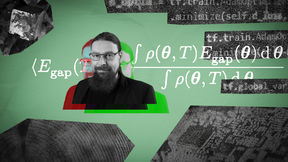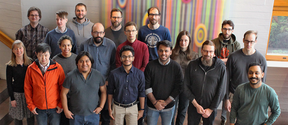Computational Electronic Structure Theory (CEST)
CEST is developing electronic structure and machine learning methods and applying them to computational materials science problems.

For nearly ten years, Professor Patrick Rinke of the Department of Applied Physics has been a pioneering presence in machine learning methodology in materials science. Rinke learned the ropes on the job, wrote algorithms and taught the methods already in 2016 when few had a clear idea what AI could do.
Since then, machine learning in materials science has become a global research trend. Rinke’s expertise in finding sustainable and climate-friendly material configurations has arguably never been more in demand.
Patrick Rinke came to Aalto in 2014 with a background in computational physics and quantum mechanics. For much of his academic career, from Germany to the UK to the US, he has modeled the complex behavior found at the atomic level with computational tools.
'In high school, I was good at math, physics, and computer science. But I couldn't decide what I wanted to study at university. I thought math was too hard, and computer science too new. Ultimately, I did a physics degree while veering towards computational physics, which combined all three things I was good at,' Rinke says.
Already in 2014—a decade before ChatGPT made AI ubiquitous—Rinke was curious about machine learning. He found equally curious partners at Aalto, and together they experimented with AI and machine learning in a physics context.
‘When I started as a professor, almost nobody in Finland was developing this kind of machine learning methodology in physics. The people who hired me at Aalto were just as interested as I was as to whether it would work,’ Rinke says.
And work it did. Recently promoted to full professorship at Aalto, Rinke heads the Computational Electronic Structure and Theory (CEST) group who apply machine learning methodology of their own devising to advance materials science and help scientists from across disciplines to take their work to the next level.
Patrick RinkeWe can dream up all sorts of materials, but nature has to tell us which can actually be made.
According to Rinke, the 'materials' in 'materials science' refers to anything that’s solid or somewhat close to that state. So: minerals, metals, ceramics, biomass, yarns, even the very chips themselves the machine-learning AI runs on. Materials scientists investigate the atomic structures to find combinations or arrangements that yield either new materials or unlock new properties in familiar ones.
‘We can dream up all sorts of materials, but then nature has to tell us which materials can actually be made, and which are stable. There are some atomic configurations that would just fly apart immediately. Or they could transform into a different configuration that’s more stable, but less interesting. Our work is to find out what combinations are realistic.”
Rinke attributes materials science to many of the world-altering advances of the last few decades.
‘It’s why we have things like electric cars, increased computing power via the ever-decreasing size of computer chips and recyclable materials replacing plastics. Materials science has had a hand in all of these and much more,’ Rinke says.
Much of the research process happens by hand–combining, measuring, analyzing materials—so the task is arduous. Since being solid can take many forms, possible combinations of various materials quickly outrun current computational capabilities. To narrow down the variables, scientists have mostly stuck to exploring materials they already know something about.
Rinke’s breakthrough—to have AI help crunch the numbers—is like entering a horse race with a Lamborghini.
‘Machine learning methods speed up the calculation process in a revolutionary way, making it possible to explore combinations outside of what we already know to work. A lot of material science is trial-and-error, and we’ve found a way to greatly accelerate that,’ Rinke says.
In practice, Rinke and his group write their own machine learning algorithms and inject them into supercomputers. The machine learning -focused sections of the supercomputing infrastructures then run the calculations, supported by various scripts Rinke’s team also provides. The calculations are based on data that’s made up of atomic structures and similar scientific descriptions. Then Rinke and the group interpret the results and suggest promising material configurations to collaborators such as engineers, chemists or atmospheric scientists.
Patrick RinkeGlobal challenges require a concerted research effort, and collaboration is key in advancing science.
Rinke’s theme is sustainability: anything that generates green power, lowers power consumption, reduces waste or aids in the fight against climate change. Right now, he is involved in an atmospheric science project, developing novel photovoltaic materials, creating AI computer chips that mimic the human brain's structural energy efficiency, and helping create plastics alternatives from biomass like wood.
His favorite materials at the moment are minerals called perovskites.
‘Perovskites offer a much larger design space compared to silicon, which is the baseline for many applications. We’re investigating perovskite-based solar cells, which could lead to solar panels that are more effective in energy conversion and cheaper to make than the ones we have now. Or they could even be used to make indoor solar panels that capture room lighting, creating an energy-saving loop.’
Sustainable materials development can help us address global challenges and with AI we can accelerate the development. AI also enables collaboration across disciplinary boundaries.
‘Global challenges require a concerted research effort, and collaboration is key in advancing science. AI methodology can be applied to nearly any domain, and it has opened up many new collaborations for me.’ Rinke says.
Case-in-point: atmospheric science. Some years ago, Rinke stumbled across a talk given by an atmospheric scientist, which described the vast amounts of molecular data required for modelling the atmosphere. By coincidence, Rinke had just been working with similar molecular data, and a lively discussion with the presenter revealed that the AI methodology would be a boon for atmospheric science. Fast-forward a few years, and Rinke is now part of the Virtual Laboratory for Molecular-Level Atmospheric Transformations; a Center of Excellence that studies how organic aerosols form and grow in the atmosphere.
As Rinke’s methodology proves more and more successful, he would like to see its full power harnessed during the coming years.
‘The data from, for example, e-commerce or entertainment is orders of magnitude more advanced than what material science can currently muster. The data coming from fields like biomaterials, chemistry or electrical engineering is simply not digitized enough so we cannot access everything that’s out there. This is something I want to improve.’
Rinke is also curious about the pursuit of entirely new materials—discovery, as he calls it. In addition to good data and sophisticated AI algorithms, discovery requires tried-and-true insight into the physics and chemistry of materials. The road to any novel material—be it ceramic, metal, organic or anything else solid—is bound to be strewn with surprises.
‘There’s simply no telling what kind of materials configurations we may find. Add to that the leaps and bounds in which AI is advancing, and you have a field and methodology that keep me forever fascinated and inspired.’
Backed by a fantastic research group and equally curious interdisciplinary collaborators, Rinke is confident in carrying on his pioneering work with computational physics, materials science and machine learning at Aalto.

CEST is developing electronic structure and machine learning methods and applying them to computational materials science problems.

The Finnish Center for Artificial Intelligence FCAI is a research hub initiated by Aalto University, the University of Helsinki, and the Technical Research Centre of Finland VTT. The goal of FCAI is to develop new types of artificial intelligence that can work with humans in complex environments, and help modernize Finnish industry. FCAI is one of the national flagships of the Academy of Finland.



